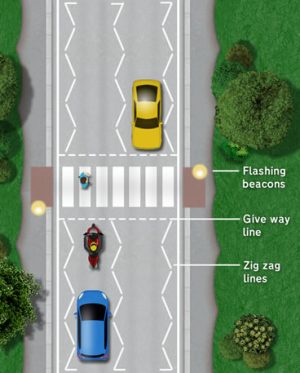Pedestrian Crossings
In order to pass the motorcycle on-road test, you’ll need to know how to deal with pedestrian crossings. There are various types of pedestrian crossings. Here, we shall cover which type of crossings you’ll encounter, along with the rules associated with them.
Zebra Crossing
Easily differentiated from other crossings due to the flashing yellow beacons at both sides of the crossing and the black and white stripes across the road. Some Zebra crossings have a centre island. White zigzag road markings are painted each side of the crossing along with a give way line about 1 metre from the crossing.

Rules
- Where pedestrians are on the pavement and are waiting to cross, slow down and stop just before the give way line.
- Give way to any pedestrian already on the crossing and allow them to safely cross before moving off.
- You must not wave people across as you never know what other vehicles are going to do and if the pedestrian has seen them.
- If a Zebra crossing has a central island, each half is classed as a separate crossing.
Pelican Crossing
Pelican crossings are traffic light controlled where pedestrians press a button to stop the traffic. The crossing area for pedestrians is marked by studs and a ‘stop’ line marks the area where drivers must stop when required.
Rules
- Pelican crossings do not have a red and amber light phase before the green and instead have a flashing amber. During a flashing amber, you must give way to pedestrians on the crossing, but if the crossing is clear, you can move off.
- A straight Pelican crossing that goes straight across the road is considered one crossing, even if there’s a central refuge area. In this instance, you must wait for pedestrians coming from the other side of the refuge area.
- A staggered Pelican crossing where the crossing each side of the refuge area are not in line are considered separate crossings.
Puffin Crossing
Puffin crossings are modern, user-friendly crossings where cameras and electronics monitor the crossing area. The system detects when the crossing is in use and delays the green light until pedestrians have reached a position of safety.
The crossing detects if a pedestrian crosses quickly and will shorten the pedestrian phase. If a pedestrian has already crossed the road before the pedestrian crossing phase has begun, it will automatically be cancelled to allow traffic to continue. Due to this process, Puffin crossings help to reduce traffic congestion and they do not have the flashing amber phase.
Toucan Crossing
Toucan crossing, or ‘two-can’ cross can be used by both cyclists and pedestrians at the same time. Cyclists can remain mounted and ride across. The signals are push-button operated and as with the Puffin crossing, there’s no flashing amber phase.
Equestrian Crossing
These crossings are for horses, have a wider crossing area and have safety barriers on the pavement. The signals are push-button operated and are located higher to enable horse riders to operate the button whilst remaining mounted. As with Puffin and Toucan crossing, there’s no flashing amber phase.
Rules
- Horses can be startled easily. Ensure that you do not rev your engine or sound your horn.
Pedestrian Crossing Rules
Along with crossing specific rules detailed above, these rules apply to all pedestrian crossings.
- You must not park on the crossing as this will block the way for pedestrians, or within the areas either side of the crossing marked by white zigzag lines. This obscures the view of approaching traffic for pedestrians and obscures the view of the crossing for oncoming road users. Parking in this area is illegal and may result in penalty points on your licence and a fine.
- You must not overtake the moving vehicle nearest to the crossing or the vehicle that has stopped to give way to pedestrians.
Motorcycle Riding Tips for Approaching Pedestrian Crossings
- Anticipation and planning is key. Look well ahead for indications of pedestrian crossings. This could be the flashing beacons of the Zebra crossing or traffic light signals.
- As you approach a crossing, ask yourself; are there people waiting at the lights, how long have they been there and is it likely the lights will soon change?
- Allow people plenty of time to cross, particularly if they’re older or disabled.
- Before moving off, take a look up and down the crossing to ensure it’s clear. There might be someone making a last second dash for it.
- Always avoid stopping on the crossing path. If at times of congestion and traffic is queuing, ensure you can clear the crossing area. If in doubt, stop before.
- Allow plenty of time to stop if pedestrian light signals change. Allow more time if the roads are wet.